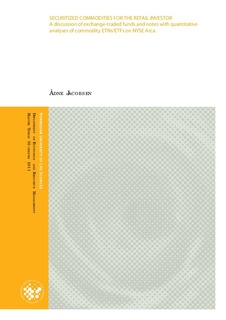| dc.description.abstract | A discussion of exchange-traded funds and notes with quantitative analyses of commodity ETNs/ETFs on NYSE Arca. The unleveraged, non-inverse commodity ETP trackers analyzed in the thesis generally have low tracking errors. There are some exception in the case of the ETFs United States Oil Fund (OIL) and United States Natural Gas Fund (UNG) which not have been reliably trackers for parts of the research period, at least not when front month futures spot prices are utilized as their respective benchmarks.
When ETNs and ETFs that are tracking the same commodities are compared the results indicate that ETNs may not be gaining much in terms of returns or tracking error ability over the ETFs. The retail investor that is trading ETPs can probably just as well choose the
physical ETF over the ETN, not least due to counterparty default risk of ETNs.
Derivative based mutual funds and ETPs in the broad commodity category seem to be quite similar in terms of returns even when mutual fund frontloads are accounted for. ETFs in the precious metal selection and derivative based ETPs in the energy selections seem to be a
preferred choice over generally more equity based mutual funds and ETPs in terms of bringing diversification gains to a broad market portfolio. In the choice of the mutual fund versus the ETN that is relating to DJ-UBS CI TR, the mutual
fund is higher ranked by some of the risk adjusted measures. This is contrary to the findings for the S&P GSCI TR related securities, where the ETPs seem to be a preferred choice compared to the respective mutual fund of that index.
Deutsche Bank’s optimal yield technology ETFs that optimizes effects of roll yield in futures markets might have a slight comparative advantage over comparable ETFs in the broad commodity and energy markets. For the precious metal markets the physical depot ETFs are probably preferable over Deutsche Bank’s ETFs when comparing returns for single precious metal ETFs. The quantitative results which I have calculated with traditional return/risk measures may not
appropriately take into account the risk inherent in some of the ETP structures, e.g. the uncollateralized ETN. An option strategy for management of ETN counterparty default is suggested. Risks of busts due to bubble-like tendencies in some of the commodity markets,
and the effects potential busts might have on the functioning of ETPs, is also challenging to include with traditional risk calculations based on historical data. However, the unleveraged,
non-inverse commodity ETP trackers analyzed in this thesis subsequent to chapter 1 seem to generally have performed quite well in obtaining low tracking errors during the financial
crisis a period which started off with high commodity prices similarly to what has been seen in commodity markets from 2009 onwards. | en_US |
